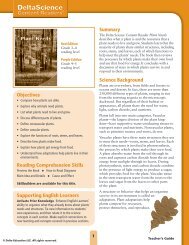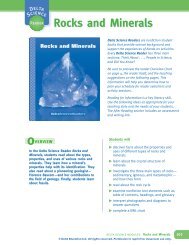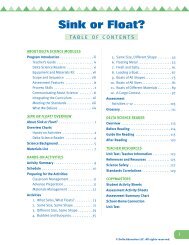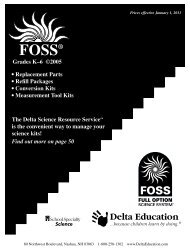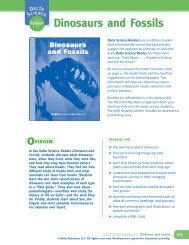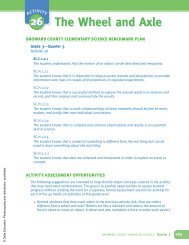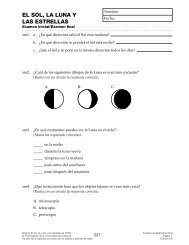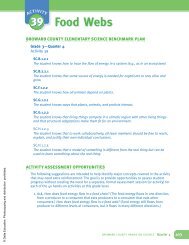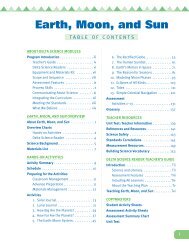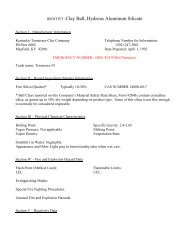The Earth-Moon System The Earth-Moon System - Delta Education
The Earth-Moon System The Earth-Moon System - Delta Education
The Earth-Moon System The Earth-Moon System - Delta Education
Create successful ePaper yourself
Turn your PDF publications into a flip-book with our unique Google optimized e-Paper software.
4Guiding the ActivityHave students measure the string with theirmeasuring tapes and record its length ontheir activity sheets. Ask, How did the actualscale distance between <strong>Earth</strong> and <strong>Moon</strong>compare with your predictions?Write satellite on the board. Ask, What is asatellite?Ask, Does anyone know the name of thefirst satellite to orbit <strong>Earth</strong>?Write natural satellite and artificial satelliteon the board. Explain that the <strong>Moon</strong> is anatural satellite. But point out that <strong>Earth</strong> alsohas many smaller manufactured satellites,or artificial satellites, that are used forcommunication, weather monitoring, andother data collection purposes.Have students predict on their activity sheetshow far from <strong>Earth</strong> most artificial satellitestravel.<strong>The</strong>n have teams take the tiniest dot of claythey can from their model <strong>Earth</strong> and hold itbetween <strong>Earth</strong> and the <strong>Moon</strong>, 20 cm (8 in.)from <strong>Earth</strong>. Explain that the position of thisbit of clay represents the altitude of some ofthe most distant <strong>Earth</strong> satellites! (See Figure5-3 for an accurate distance model of <strong>Earth</strong>’ssatellites.)Additional InformationAllow students time to express their surpriseor other responses. Students may beinterested to know that the true diameter of<strong>Earth</strong> is about 12,800 km (8,000 mi) and themean distance from <strong>Earth</strong> to the <strong>Moon</strong> isabout 380,000 km (230,000 mi).Students may know that a satellite is anobject that orbits a planet.Students may answer with the name of anearly artificial satellite, but probably will saythat they do not know. <strong>The</strong> answer actually isthe <strong>Moon</strong>.Approximately 3,000 artificial satellites arecurrently in orbit around <strong>Earth</strong>.Each team also can hold up the <strong>Earth</strong> modeland a tiny speck of clay to demonstrate ateam prediction.This distance corresponds to an altitude ofabout 35,000 km (22,000 mi) and is thedistance of certain satellites that orbit <strong>Earth</strong>at the same rate at which <strong>Earth</strong> spins and,therefore, that maintain their position abovethe same spot on <strong>Earth</strong> at all times. <strong>The</strong> mostcommon satellites of this kind are theweather satellites that produce the picturesseen on television weather reports.the <strong>Earth</strong>, surrounded byartificial satellitesmost distant artificial satellitesthe <strong>Moon</strong>, <strong>Earth</strong>’snatural satellite Figure 5-3. An accurate distance model of <strong>Earth</strong> and its satellites (not accurate to size).delta science modules <strong>Earth</strong>, <strong>Moon</strong>, and Sun 49



